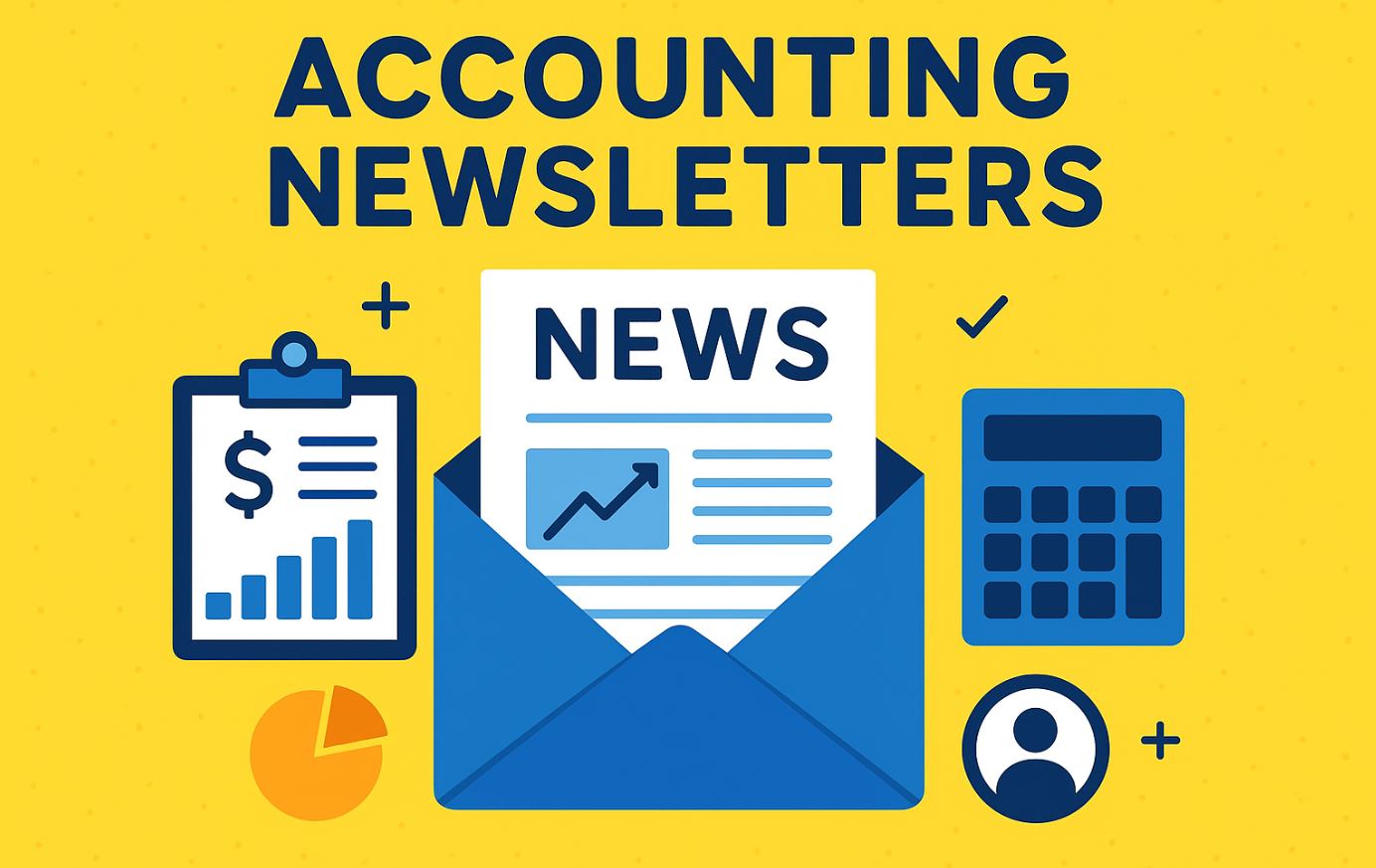What Are Accounting Newsletters?

Accounting newsletters are specialized publications delivered periodically, often via email, that provide updates, insights, and analyses on various aspects of the accounting profession. These newsletters serve as a vital resource for accountants, CPAs, bookkeepers, and financial professionals, keeping them informed about the latest developments in tax laws, auditing standards, financial reporting, and industry trends. Unlike traditional magazines or journals, accounting newsletters are typically concise, timely, and tailored to busy professionals who need quick access to relevant information without sifting through voluminous texts.
Moreover, in an era where regulations change rapidly, these newsletters act as a bridge between complex financial concepts and practical application. For instance, they might highlight new IRS guidelines or emerging technologies like AI in accounting. According to various sources, accounting newsletters have become indispensable tools for staying competitive in a field that demands continuous learning. They can be produced by professional organizations, consulting firms, media outlets, or individual experts, each offering a unique perspective.
Furthermore, the format of these newsletters has evolved with digital advancements. Early versions were printed mailers, but today, they are predominantly digital, allowing for interactive elements like links to webinars or downloadable resources. This shift has made them more accessible and engaging. In essence, accounting newsletters are not just informational; they are strategic assets that help professionals navigate the complexities of finance with confidence and efficiency.
Transitioning to their importance, it’s crucial to understand why these newsletters have gained such prominence in the professional landscape.
Why Are Accounting Newsletters Important in Today’s Financial World?
In today’s fast-paced financial environment, accounting newsletters play a pivotal role in ensuring professionals remain ahead of the curve. With global economic shifts, regulatory updates, and technological innovations occurring at an unprecedented rate, staying informed is not optional—it’s essential. For example, newsletters often break down complex topics like the implications of new sustainability reporting standards or cybersecurity risks in financial data management, making them easier to digest.
Additionally, these newsletters foster a sense of community among accounting professionals. By subscribing, individuals gain access to expert opinions, case studies, and peer experiences that might otherwise be inaccessible. This is particularly beneficial for solo practitioners or those in small firms who lack extensive internal resources. Research indicates that regular engagement with such content can lead to better decision-making and reduced compliance risks.
However, the importance extends beyond individual growth. For accounting firms, newsletters serve as marketing tools, helping to build client relationships by demonstrating expertise. Clients appreciate receiving curated insights that affect their businesses, such as tax-saving strategies or economic forecasts. Thus, newsletters enhance trust and loyalty.
Moreover, in a post-pandemic world where remote work is prevalent, these publications provide a virtual lifeline for networking and professional development. They often include invitations to virtual events or forums, bridging geographical gaps. Overall, the significance of accounting newsletters lies in their ability to transform information overload into actionable knowledge, empowering professionals to thrive amid uncertainty.
As we delve deeper, let’s explore the mechanics behind these valuable resources.
What Topics Do Accounting Newsletters Typically Cover?
Accounting newsletters encompass a wide array of topics, reflecting the multifaceted nature of the profession. Core areas include tax updates, such as changes in federal and state laws, which are crucial during filing seasons. For instance, discussions on deductions, credits, and international tax treaties are common.
Additionally, auditing and assurance services feature prominently, with insights into new standards from bodies like the AICPA. Newsletters might explore risk assessment techniques or fraud detection methods, helping professionals mitigate liabilities.
Financial reporting is another staple, covering GAAP and IFRS developments. Topics like revenue recognition or lease accounting are dissected with practical examples. Emerging trends, such as the integration of AI and blockchain in accounting, are increasingly highlighted, offering forward-looking perspectives.
Moreover, practice management advice, including firm growth strategies, client acquisition, and technology adoption, appeals to firm owners. Economic analyses, cybersecurity, and sustainability reporting round out the content, addressing broader business implications.
However, specialized newsletters might focus on niches like nonprofit accounting or forensic auditing. This diversity ensures that there’s something for every professional level, from entry-level accountants to CFOs.
With this variety in mind, consider who stands to gain the most from these resources.
Who Should Subscribe to Accounting Newsletters?

Subscription to accounting newsletters is ideal for a broad spectrum of individuals and organizations within the financial sector. Primarily, certified public accountants (CPAs) and bookkeepers benefit immensely, as they require constant updates to maintain certifications and deliver accurate services.
Furthermore, financial controllers, auditors, and tax advisors find value in the specialized insights that enhance their daily operations. Students and early-career professionals can use them for learning and staying abreast of industry shifts, aiding career progression.
Business owners and executives outside the accounting field also subscribe to understand financial implications for their companies. For example, entrepreneurs might seek advice on cash flow management or compliance.
Additionally, educators and researchers utilize newsletters for curriculum development and scholarly work. Even policymakers or regulators might reference them for public discourse.
However, the key is relevance—subscribing to newsletters aligned with one’s role maximizes benefits. In a competitive job market, this knowledge edge can lead to promotions or new opportunities.
Transitioning forward, selecting the appropriate newsletter is crucial for optimal engagement.
How to Choose the Right Accounting Newsletter for Your Needs?
Choosing the right accounting newsletter involves assessing several factors to ensure it aligns with your professional goals. First, identify your focus areas—tax, auditing, or general finance—and seek newsletters specializing in those.
Moreover, evaluate the publisher’s credibility. Established organizations like the AICPA or Deloitte offer reliable content, backed by expert teams. Read sample issues to gauge writing style and depth; some are concise summaries, others in-depth analyses.
Frequency matters too—daily for quick updates or weekly for comprehensive overviews. Consider user reviews and subscription costs, though many are free.
Additionally, look for interactive features like podcasts or community forums. Tools like RSS feeds can help manage multiple subscriptions.
However, avoid overload by starting with a few and expanding based on value. Ultimately, the best newsletter enhances your knowledge without overwhelming your inbox.
Now, let’s spotlight some standout examples in the current landscape.Accounting newsletters are specialized publications delivered periodically, often via email, that provide updates, insights, and analyses on various aspects of the accounting profession. These newsletters serve as a vital resource for accountants, CPAs, bookkeepers, and financial professionals, keeping them informed about the latest developments in tax laws, auditing standards, financial reporting, and industry trends. Unlike traditional magazines or journals, accounting newsletters are typically concise, timely, and tailored to busy professionals who need quick access to relevant information without sifting through voluminous texts.
Moreover, in an era where regulations change rapidly, these newsletters act as a bridge between complex financial concepts and practical application. For instance, they might highlight new IRS guidelines or emerging technologies like AI in accounting. According to various sources, accounting newsletters have become indispensable tools for staying competitive in a field that demands continuous learning. They can be produced by professional organizations, consulting firms, media outlets, or individual experts, each offering a unique perspective.
Furthermore, the format of these newsletters has evolved with digital advancements. Early versions were printed mailers, but today, they are predominantly digital, allowing for interactive elements like links to webinars or downloadable resources. This shift has made them more accessible and engaging. In essence, accounting newsletters are not just informational; they are strategic assets that help professionals navigate the complexities of finance with confidence and efficiency.
Transitioning to their importance, it’s crucial to understand why these newsletters have gained such prominence in the professional landscape.
How Do Accounting Newsletters Work?

Accounting newsletters operate on a subscription-based model, where users sign up to receive periodic emails containing curated content. The process begins with content creation: editors or authors gather information from reliable sources, such as regulatory bodies like the FASB or SEC, and synthesize it into digestible articles. Frequency varies—some are daily, like CPA Letter Daily, while others are weekly or monthly, allowing for in-depth analysis.
Furthermore, modern newsletters leverage technology for personalization. Subscribers might choose topics of interest, such as tax or auditing, ensuring relevance. Delivery platforms like Substack or Mailchimp enable seamless distribution, with features like analytics to track open rates and engagement.
Once received, readers can interact by clicking links to full articles, videos, or podcasts. This interactive element distinguishes them from static publications. For creators, feedback loops—through surveys or comments—help refine future issues.
However, challenges like information accuracy are addressed through rigorous fact-checking and citations. Popular newsletters often collaborate with experts to maintain credibility. In summary, the workflow of accounting newsletters combines content curation, digital delivery, and user engagement to provide timely value.
Building on this, it’s worth examining the breadth of subjects they address.
How Do Services Like Canopy, Earmark, Firm360, Keeper, and Sage Support Accounting Professionals?
Accounting newsletters are indispensable tools for professionals seeking to stay informed in the rapidly evolving world of finance and compliance. These curated publications, typically delivered via email or digital platforms, provide timely updates on tax regulations, auditing standards, practice management strategies, and emerging technologies.
Canopy, Earmark, Firm360, Keeper, and Sage
Services like Canopy, Earmark, Firm360, Keeper, and Sage have become go-to sources for accountants, offering specialized content tailored to the diverse needs of CPAs, bookkeepers, and firm owners. For instance, Canopy’s newsletters focus on practice management, offering insights into client relationship management, workflow automation, and tax preparation tools that streamline firm operations.
Similarly, Earmark, led by industry thought leader Blake Oliver, delivers engaging content that blends technical updates with practical advice, often highlighting trends like cloud accounting and AI-driven solutions.
Meanwhile, Firm360’s newsletters emphasize operational efficiency, providing tips on optimizing workflows, managing client data, and scaling small to mid-sized firms.
Keeper stands out for its focus on tax and compliance, offering concise updates on legislative changes and actionable strategies for tax professionals.
Sage, a leader in accounting software, provides newsletters that dive into financial management, software integrations, and best practices for leveraging technology to enhance client services. Importantly, these services cater to different niches within the accounting profession, ensuring professionals receive relevant, high-value information. For example, a solo practitioner might rely on Keeper for tax season updates, while a growing firm might turn to Firm360 for guidance on team collaboration tools.
Moreover, these newsletters save time by curating critical information, eliminating the need to scour multiple sources for updates. By subscribing to these services, accountants gain access to expert insights, industry trends, and practical tools that enhance their ability to serve clients effectively.
Additionally, many of these newsletters incorporate community-driven content, such as case studies or webinars, fostering a sense of connection among professionals. As the accounting landscape continues to shift with new regulations and technological advancements, newsletters from Canopy, Earmark, Firm360, Keeper, and Sage empower professionals to stay compliant, competitive, and confident in their decision-making. Ultimately, these services are more than just newsletters; they are strategic resources that help accountants navigate complexity, adopt innovative solutions, and deliver exceptional value to their clients.
How Can Accounting Newsletters Boost Your Professional Development?

Accounting newsletters significantly boost professional development by providing continuous education opportunities. They offer CPE-eligible content, helping maintain certifications without formal courses.
Furthermore, exposure to diverse viewpoints sharpens critical thinking and problem-solving skills. Case studies in newsletters illustrate real-world applications, bridging theory and practice.
Networking is another benefit—many include event listings or contributor bios, facilitating connections. For career changers, insights into emerging fields like forensic accounting open new paths.
Additionally, regular reading builds expertise, positioning you as a thought leader in your firm or community. This can lead to speaking engagements or publications.
However, active engagement, like applying learned strategies, maximizes gains. In a field where knowledge is power, newsletters are catalysts for growth and success.
Shifting focus, what distinguishes exceptional newsletters from the rest?
What Makes an Effective Accounting Newsletter Stand Out?
An effective accounting newsletter stands out through timeliness, relevance, and clarity. Content must be current, addressing immediate issues like regulatory changes.
Moreover, depth without jargon ensures accessibility for varied audiences. Visual aids, like infographics, enhance readability.
Credibility is key—sourcing from experts and including citations builds trust. Engagement features, such as polls or Q&A sections, foster interaction.
Consistency in delivery and branding creates reliability. Personalization, via segmented content, increases value.
However, avoiding overload by focusing on quality over quantity is crucial. Ultimately, standout newsletters educate, inspire, and connect.
For those inspired, starting one might be the next step.
How Can You Create and Launch Your Own Accounting Newsletter?
Creating an accounting newsletter begins with defining your niche and audience—perhaps tax tips for small businesses.
Next, choose a platform like beehiiv or Substack for easy setup. Develop a content calendar, sourcing from reliable data.
Write engagingly, using headlines and bullet points. Include calls-to-action for subscriptions or shares.
Promote via social media, LinkedIn, or your website. Start small, perhaps bi-weekly, and gather feedback.
Additionally, comply with email regulations like CAN-SPAM. Monetize through sponsorships if desired.
However, consistency is vital for growth. With dedication, your newsletter can become a valuable resource.
Despite benefits, challenges persist in this space.
What Challenges Do Accounting Newsletters Face in the Digital Age?
In the digital age, accounting newsletters face challenges like information saturation, where subscribers ignore emails amid inbox clutter.
Moreover, maintaining accuracy amid rapid changes requires constant vigilance, risking errors if not fact-checked.
Competition is fierce, with numerous options diluting audiences. Privacy concerns and data regulations complicate distribution.
Additionally, adapting to AI-generated content raises authenticity issues. Economic factors, like ad revenue dips, affect sustainability.
However, opportunities in multimedia integration can mitigate these. By innovating, newsletters can overcome hurdles and thrive.
To wrap up, here are some frequently asked questions.
FAQs

An accounting newsletter is delivered directly to subscribers’ inboxes periodically, offering curated, timely content. In contrast, a blog is a website-based platform where articles are posted for on-demand reading, often with less structure in delivery.
Frequency varies by publication: some are daily for quick updates, others weekly or monthly for deeper insights. Choose based on your preference for information flow.
Many are free, supported by ads or sponsorships, but some premium ones require subscriptions for exclusive content. Always check the sign-up details.
Yes, by positioning your firm as an expert through shared insights, newsletters build trust and attract potential clients seeking knowledgeable advisors.
Most newsletters include an unsubscribe link at the bottom of emails, complying with regulations. You can also manage preferences for customized content.
You may also be interested in What is IT Service Management (ITSM)?


